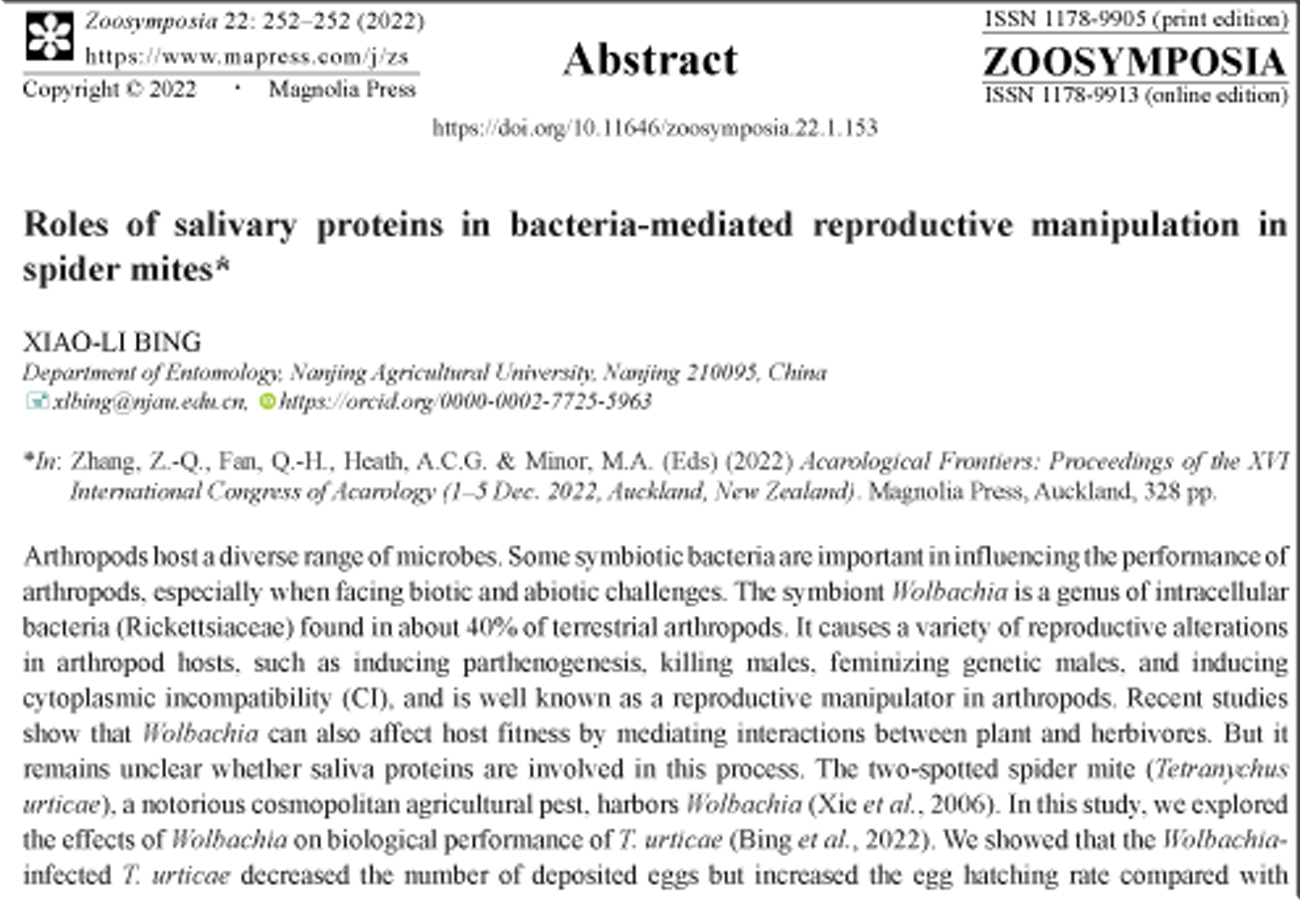Abstract
Arthropods host a diverse range of microbes. Some symbiotic bacteria are important in influencing the performance of arthropods, especially when facing biotic and abiotic challenges. The symbiont Wolbachia is a genus of intracellular bacteria (Rickettsiaceae) found in about 40% of terrestrial arthropods. It causes a variety of reproductive alterations in arthropod hosts, such as inducing parthenogenesis, killing males, feminizing genetic males, and inducing cytoplasmic incompatibility (CI), and is well known as a reproductive manipulator in arthropods. Recent studies show that Wolbachia can also affect host fitness by mediating interactions between plant and herbivores. But it remains unclear whether saliva proteins are involved in this process. The two-spotted spider mite (Tetranychus urticae), a notorious cosmopolitan agricultural pest, harbors Wolbachia (Xie et al., 2006). In this study, we explored the effects of Wolbachia on biological performance of T. urticae (Bing et al., 2022). We showed that the Wolbachia-infected T. urticae decreased the number of deposited eggs but increased the egg hatching rate compared with Wolbachia-uninfected mites. With transcriptomic analysis data, we further demonstrated that Wolbachia infection upregulated the gene expression levels of many T. urticae salivary proteins, which include a cluster of Tetranychidae-specific, functionally uncharacterized SHOT1s (secreted host-responsive proteins of Tetranychidae). These SHOT1 genes were highly enriched in the proterosomas (Jonckheere et al., 2018) and were expressed more in the feeding stages (nymphs and adults) of mites than in eggs. RNAi experiments showed that knocking down SHOT1s could significantly decrease Wolbachia titer, increase the number of deposited eggs and decrease the egg hatching rate. Altogether, our results suggest that host salivary proteins are related to Wolbachia-mediated manipulations of host reproduction.
References
Bing, X.-L., Xia, C.-B., Ye, Q.-T., Gong, X., Cui, J.-R., Peng, C.-W. & Hong, X.-Y. (2022) Wolbachia manipulates reproduction of spider mites by influencing herbivore salivary proteins. Pest Management Science. https://doi.org/10.1002/ps.7201
Jonckheere, W., Dermauw, W., Khalighi, M., Pavlidi, N., Reubens, W., Baggerman, G., Tirry, L., Menschaert, G., Kant, M.R., Vanholme, B. & Van Leeuwen, T. (2018) A gene family coding for salivary proteins (SHOT) of the polyphagous spider mite Tetranychus urticae exhibits fast host-dependent transcriptional plasticity. Molecular Plant-Microbe Interactions, 31, 112–124.
Xie, L., Miao, H. & Hong, X.-Y. (2006) The two-spotted spider mite Tetranychus urticae Koch and the carmine spider mite Tetranychus cinnabarinus (Boisduval) in China mixed in their Wolbachia phylogenetic tree. Zootaxa, 1165, 33–46. https://doi.org/10.11646/zootaxa.1165.1.2


